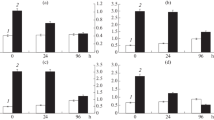Abstract
Phenol was absorbed unspecifically by active and by inactivated cells of a strictly anaerobic, phenol-degrading consortium to reach about twice the concentration of the medium. The absorption was temperature-dependent. A Q10 of 1.7 was determined, indicating that accumulation was due to diffusion or facilitated diffusion and not to an active transport process. At increasing phenol concentration in the medium, concentrated cell suspensions adsorpted phenol proportionally until saturation was reached at about 25 nmol phenol/mg cell dry weight. At a phenol concentration in the medium of 2 mm, the washed cell pellet contained 3.5 mm phenol. Under conditions that allowed phenol metabolism (presence of CO2), [14C]4-hydroxybenzoyl-coenzyme A and [14C]4-hydroxybenzoate were found as early intermediates of [U-14C]phenol degradation for the first time. [14C]Benzoate was excreted stoichiometrically if phenol degradation to acetate was prevented by H2. Absolutely no 14C-label was found in the phenylphosphate peak after HPLC separation, which excluded phosphorylation of phenol during uptake or during degradation in the cells.
Similar content being viewed by others
References
Auburger G, Winter J (1992) Purification and characterization of a benzoyl-CoA ligase from a syntrophic, benzoate-degrading, anaerobic mixed culture. Appl Microbiol Biotechnol 37:789–795
Balch WE, Fox EE, Magrum LJ, Wolfe RS (1979) Methanogens: reevaluation of a unique biological group. Microbiol Rev 43:260–296
Bradford M (1976) A rapid and sensitive method for quantitation of microgram quantities of protein utilizing the principle of protein-dye binding. Anal Biochem 72:248–254
Bray GA (1960) A simple and efficient liquid scintillator for counting aqueuous solutions in a liquid scintillation counter. Anal Biochem 1:279–285
Dangel W, Brackmann R, Lack A, Mohamed M, Koch J, Oswald B, Seyfried B, Tschech A, Fuchs G (1991) Differential expression of enzyme activities initiating anoxic metabolism of various aromatic compounds via benzoyl-CoA. Arch Microbiol 155:256–262
DiMarco AA, Romano AH (1985) d-Glucose tansport system of Zymomonas mobilis. Appl Environ Microbiol 49:151–157
Gallert C, Winter J (1992) Comparison of 4-hydroxybenzoate decarboxylase and phenol carboxylase activities in cell-free extracts of a defined, 4-hydroxybenzoate and phenol-degrading anaerobic consortium. Appl Microbiol Biotechnol 37:119–124
Gallert C, Knoll G, Winter J (1991) Anaerobic carboxylation of phenol to benzoate: use of deuterated phenols revealed carboxylation exclusively in the C4-position. Appl Microbiol Biotechnol 36:124–129
Harwood CS, Gibson J (1986) Uptake of benzoate by Rhodopseudomonas palustris grown anaerobically in light. J Bacteriol 165:504–509
Janssen PH (1992) Growth yield increase and ATP formation linked to succinate decarboxylation in Veillonella parvula. Arch Microbiol 157:442–445
Janssen PH, Hartfoot CG (1992) Anaerobic malonate decarboxylation by Citrobacter diversus. Growth and metabolic studies, and evidence of ATP formation. Arch Microbiol 157:471–474
Knoll G, Winter J (1987) Anaerobic degradation of phenol in sewage sludge: benzoate formation from phenol and CO2 in the presence of hydrogen. Appl Microbiol Biotechnol 25:384–391
Knoll G, Winter J (1989) Degradation of phenol via carboxylation to benzoate by a defined, obligate syntrophic consortium of anaerobic bacteria. Appl Microbiol Biotechnol 30:318–324
Lack, A, Fuchs G (1992) Carboxylation of phelylphosphate by phenol carboxylase, an enzyme system of anaerobic phenol metabolism. J Bacteriol 174:3629–3636
Sharak Genthner BR, Townsend GT, Chapman PJ (1989) Anaerobic transformation of phenol to benzoate via para-carboxylation: use of fluorinated analogues to elucidate the mechanism of transfromation. Biochem Biophys Res Commun 162:945–951
Struch T, Neuss B, Bringer-Meyer S, Sahm H (1991) Osmotic adjustment of Zymomonas mobilis to concentrated glucose solutions. Appl Microbiol Biotechnol 34:518–523
Szewzyk U, Schink B (1989) Degradation of hydrochinone, gentisate and benzoate by a fermenting bacterium in pure or defined mixed culture. Arch Microbiol 151:541–545
Thayer JR, Wheelis ML (1982) Active transport of benzoate in Pseudomonas putida. J Gen Microbiol 128:1749–1753
Tschech A, Fuchs G (1987) Anaerobic degradation of phenol by pure cultures of newly isolated denitrifying pseudomonads. Arch Microbiol 148:213–217
Tschech A, Fuchs G (1989) Anaerobic degradation of phenol via carboxylation to 4-hydroxybenzoate: in vitro studies of isotope exchange between 14CO2 and 4-hydrobenzoate. Arch Microbiol 152:594–599
Tschech A, Schink B (1986) Fermentative degradation of monohydroxybenzoates by defined synthrophic cultures. Arch Microbiol 145:396–402
Wong CM, Dilworth MJ, Glenn AR (1991) Evidence for two uptake systems in Rhizobium leguminosarum for hydroxy-aromatic compounds metabolized by the 3-oxoadipate pathway. Arch Microbiol 156:385–391
Zhang X, Morgan TV, Wiegel J (1990) Conversion of 13C-1-phenol of chlorophenols. FEMS Microbiol Lett 67:63–66
Ziegler K, Braun K, Böckler A, Fuchs G (1987) Studies on the anaerobic degradation of benzoic acid and 2-aminobenzoic acid by a denitrifying Pseudomonas strain. Arch Microbiol 149:62–69
Ziegler K, Buder R, Winter J, Fuchs G (1989) Activation of aromatic acids aerobic 2-aminobenzoate metabolism in a denitrifying Pseudomonas strain. Arch Microbiol 151:171–1769
Author information
Authors and Affiliations
Additional information
Correspondence to: J. Winter
Rights and permissions
About this article
Cite this article
Gallert, C., Winter, J. Uptake of phenol by the phenol-metabolizing bacteria of a stable, strictly anaerobic consortium. Appl Microbiol Biotechnol 39, 627–631 (1993). https://doi.org/10.1007/BF00205065
Received:
Accepted:
Issue Date:
DOI: https://doi.org/10.1007/BF00205065




